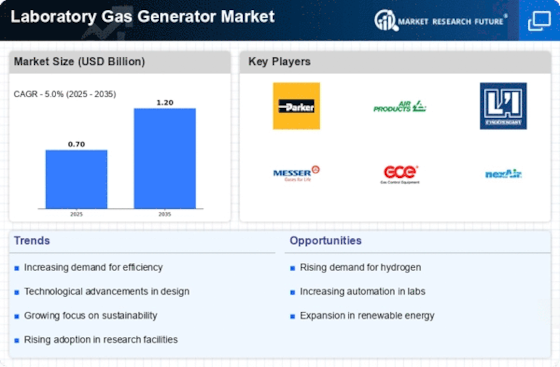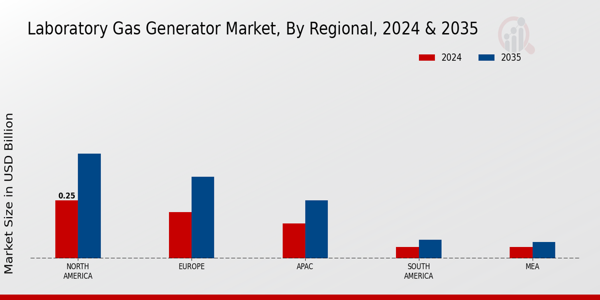Rising Demand for Clean Energy Solutions
The Laboratory Gas Generator Market is experiencing a notable increase in demand for clean energy solutions. As industries strive to reduce their carbon footprint, the shift towards sustainable practices is becoming more pronounced. Laboratory gas generators, which produce gases on-site, eliminate the need for traditional gas cylinders, thereby reducing transportation emissions. This trend is supported by various environmental regulations that encourage the adoption of cleaner technologies. According to recent data, the market for laboratory gas generators is projected to grow at a compound annual growth rate of approximately 6% over the next five years, driven by the need for eco-friendly alternatives in laboratory settings. This growth reflects a broader commitment to sustainability across multiple sectors, further solidifying the role of laboratory gas generators in achieving environmental goals.
Regulatory Compliance and Safety Standards
The Laboratory Gas Generator Market is significantly shaped by the increasing emphasis on regulatory compliance and safety standards in laboratory environments. Governments and regulatory bodies are implementing stringent guidelines to ensure the safe handling and use of gases in laboratories. Laboratory gas generators, which minimize the risks associated with gas storage and transportation, are becoming a preferred choice for many organizations seeking to comply with these regulations. The market is projected to grow as more laboratories prioritize safety and compliance, with estimates suggesting a growth rate of approximately 5% over the next few years. This trend indicates that adherence to safety standards not only enhances operational efficiency but also drives the demand for laboratory gas generators, reinforcing their critical role in modern laboratory practices.
Technological Innovations in Gas Generation
The Laboratory Gas Generator Market is witnessing a wave of technological innovations that enhance the efficiency and reliability of gas generation systems. Advances in membrane technology, pressure swing adsorption, and electrochemical processes are transforming how gases are produced in laboratories. These innovations not only improve the purity and consistency of the gases generated but also reduce operational costs and energy consumption. For instance, the introduction of smart gas generators equipped with IoT capabilities allows for real-time monitoring and predictive maintenance, thereby minimizing downtime. As these technologies continue to evolve, they are expected to drive the adoption of laboratory gas generators, with market analysts projecting a growth rate of around 7% in the coming years. This trend underscores the importance of staying at the forefront of technological advancements to meet the evolving needs of laboratory environments.
Growing Adoption in Educational Institutions
The Laboratory Gas Generator Market is experiencing a growing adoption of gas generators in educational institutions, particularly in universities and research colleges. As educational programs increasingly emphasize hands-on learning and practical experience, the need for reliable gas supply systems in laboratories becomes paramount. Laboratory gas generators offer a safe and efficient alternative to traditional gas supply methods, making them ideal for educational settings. Recent surveys indicate that over 60% of educational institutions are considering or have already implemented laboratory gas generators to enhance their laboratory capabilities. This trend not only supports the educational sector's commitment to providing quality training but also contributes to the overall growth of the laboratory gas generator market. As more institutions recognize the benefits of on-site gas generation, the market is likely to expand further.
Increased Research and Development Activities
The Laboratory Gas Generator Market is significantly influenced by the surge in research and development activities across various sectors, including pharmaceuticals, biotechnology, and materials science. As organizations invest heavily in R&D to innovate and develop new products, the demand for reliable and efficient gas supply systems becomes critical. Laboratory gas generators provide a consistent and high-quality gas supply, which is essential for experiments and processes that require precision. Recent statistics indicate that R&D spending in the pharmaceutical sector alone has reached over 200 billion, highlighting the potential for laboratory gas generators to support these initiatives. This trend suggests that as R&D activities expand, the laboratory gas generator market will likely see a corresponding increase in demand, reinforcing its importance in scientific advancement.



















Leave a Comment